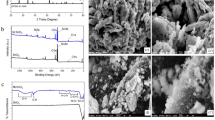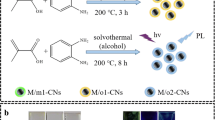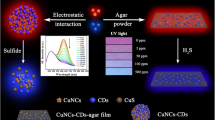Abstract
Hydrogen sulphide (H2S) is a common air pollutant, which is produced in various industry processes. Therefore, it is of crucial importance to detect H2S in real time. Many fluorescent sensors were reported aiming at detecting H2S in solution; however, the fluorescence sensing of gaseous H2S has not yet been reported. In this work, we utilized the post-functionalized fluorescent film, MIL-100(In)@Eu3+/Cu2+ film, realizing fluorescence turn-on sensing of gaseous H2S at room temperature for the first time with the limit of detection as low as 0.535 ppm, which is comparable to some reported fluorescent probes for S2− ions and semiconductor based gaseous H2S sensors. The sensor was designed due to the strong affinity of H2S with Cu2+. With the formation of CuS, the “antenna effect” between the ligand and Eu3+ recovered, resulting in the fluorescence turn-on of Eu3+ emission. Additionally, we proposed a new method to realize multi-colour anti-counterfeiting patterns with lanthanide ions ink, taking advantage of the extraordinary smooth surface and uncoordinated carboxylate groups within the MIL-100(In) film.
摘要
硫化氢气体是一种常见的工业气体, 也是一种大气污染物, 因此对硫化氢气体的实时检测具有十分重要的意义. 当前报道的硫化氢荧光探针大多是在溶液中进行探测的, 能检测硫化氢气体的荧光探针还鲜有报道. 本文利用后修饰的具有荧光发光潜力的薄膜, MIL-100(In)@Eu3+/Cu2+, 在室温下首次实现了对硫化氢气体的荧光增强型检测, 检测限可达0.535 ppm. 此探针的设计是基于硫化氢气体与Cu2+的强结合力. 当形成CuS之后, 有机配体与Eu3+之间的“天线效应”恢复, 使得Eu3+的荧光发射增强. 这个荧光探针的性能可以与溶液中检测硫化氢的荧光探针相媲美, 并且不输于传统的半导体型硫化氢气体探针. 此外, 由于MIL-100(In)薄膜表面平 整度高且具有未配位的羧基基团, 我们利用稀土离子溶液在其表面上实现了多色防伪图案.
Similar content being viewed by others
References
Kaushik A, Kumar R, Arya SK, et al. Organic-inorganic hybrid nanocomposite-based gas sensors for environmental monitoring. Chem Rev, 2015, 115: 4571–4606
Vikrant K, Kumar V, Ok YS, et al. Metal-organic framework (MOF)-based advanced sensing platforms for the detection of hydrogen sulfide. TrAC Trends Anal Chem, 2018, 105: 263–281
Sasakura K, Hanaoka K, Shibuya N, et al. Development of a highly selective fluorescence probe for hydrogen sulfide. J Am Chem Soc, 2011, 133: 18003–18005
Meng C, Cui X, Qi S, et al. Lung inflation with hydrogen sulfide during the warm ischemia phase ameliorates injury in rat donor lungs via metabolic inhibition after cardiac death. Surgery, 2017, 161: 1287–1298
Wan X, Wu L, Zhang L, et al. Novel metal-organic frameworks-based hydrogen sulfide cataluminescence sensors. Sensor Actuat B-Chem, 2015, 220: 614–621
Liu B, Chen Y. Responsive lanthanide coordination polymer for hydrogen sulfide. Anal Chem, 2013, 85: 11020–11025
Modaberi MR, Rooydell R, Brahma S, et al. Enhanced response and selectivity of H2S sensing through controlled Ni doping into ZnO nanorods by using single metal organic precursors. Sensor Actuat B-Chem, 2018, 273: 1278–1290
Tian K, Wang XX, Yu ZY, et al. Hierarchical and hollow Fe2O3 nanoboxes derived from metal—organic frameworks with excellent sensitivity to H2S. ACS Appl Mater Interfaces, 2017, 9: 29669–29676
Cui Y, Zhang J, He H, et al. Photonic functional metal—organic frameworks. Chem Soc Rev, 2018, 47: 5740–5785
Kreno LE, Leong K, Farha OK, et al. Metal-organic framework materials as chemical sensors. Chem Rev, 2012, 112: 1105–1125
Chen S, Chen Z, Ren W, et al. Reaction-based genetically encoded fluorescent hydrogen sulfide sensors. J Am Chem Soc, 2012, 134: 9589–9592
Wu Z, Li Z, Yang L, et al. Fluorogenic detection of hydrogen sulfide via reductive unmasking of o-azidomethylbenzoyl-coumarin conjugate. Chem Commun, 2012, 48: 10120–10122
Qian Y, Karpus J, Kabil O, et al. Selective fluorescent probes for live-cell monitoring of sulphide. Nat Commun, 2011, 2: 495
Liu C, Pan J, Li S, et al. Capture and visualization of hydrogen sulfide by a fluorescent probe. Angew Chem Int Ed, 2011, 50: 10327–10329
Hai Z, Bao Y, Miao Q, et al. Pyridine-biquinoline-metal complexes for sensing pyrophosphate and hydrogen sulfide in aqueous buffer and in cells. Anal Chem, 2015, 87: 2678–2684
Yang Q, Xu Q, Jiang HL. Metal-organic frameworks meet metal nanoparticles: synergistic effect for enhanced catalysis. Chem Soc Rev, 2017, 46: 4774–4808
Hu Z, Mahdi EM, Peng Y, et al. Kinetically controlled synthesis of two-dimensional Zr/Hf metal-organic framework nanosheets via a modulated hydrothermal approach. J Mater Chem A, 2017, 5: 8954–8963
Li B, Chrzanowski M, Zhang Y, et al. Applications of metal-organic frameworks featuring multi-functional sites. Coord Chem Rev, 2016, 307: 106–129
Li B, Leng K, Zhang Y, et al. Metal-organic framework based upon the synergy of a brønsted acid framework and lewis acid centers as a highly efficient heterogeneous catalyst for fixed-bed reactions. J Am Chem Soc, 2015, 137: 4243–4248
Zhang Y, Yuan S, Day G, et al. Luminescent sensors based on metal-organic frameworks. Coord Chem Rev, 2018, 354: 28–45
Lustig WP, Mukherjee S, Rudd ND, et al. Metal—organic frame-works: functional luminescent and photonic materials for sensing applications. Chem Soc Rev, 2017, 46: 3242–3285
Wang H, Lustig WP, Li J. Sensing and capture of toxic and hazardous gases and vapors by metal—organic frameworks. Chem Soc Rev, 2018, 47: 4729–4756
Cui Y, Zhu F, Chen B, et al. Metal-organic frameworks for luminescence thermometry. Chem Commun, 2015, 51: 7420–7431
Zhang M, Feng G, Song Z, et al. Two-dimensional metal-organic framework with wide channels and responsive turn-on fluorescence for the chemical sensing of volatile organic compounds. J Am Chem Soc, 2014, 136: 7241–7244
Zhou X, Cheng J, Li L, et al. A europium(III) metal-organic framework as ratiometric turn-on luminescent sensor for Al3+ ions. Sci China Mater, 2018, 61: 752–757
Yin W, Tao C, Wang F, et al. Tuning optical properties of MOF-based thin films by changing the ligands of MOFs. Sci China Mater, 2018, 61: 391–400
Zhang D, Xu Y, Liu Q, et al. Encapsulation of CH3NH3PbBr3 perovskite quantum dots in MOF-5 microcrystals as a stable platform for temperature and aqueous heavy metal ion detection. Inorg Chem, 2018, 57: 4613–4619
Zhang J, Xia T, Zhao D, et al. In situ secondary growth of Eu(III)-organic framework film for fluorescence sensing of sulfur dioxide. Senss Actuators B-Chem, 2018, 260: 63–69
Zhang J, Yue D, Xia T, et al. A luminescent metal-organic framework film fabricated on porous Al2O3 substrate for sensitive detecting ammonia. Micropor Mesopor Mater, 2017, 253: 146–150
Dou Z, Yu J, Cui Y, et al. Luminescent metal-organic framework films as highly sensitive and fast-response oxygen sensors. J Am Chem Soc, 2014, 136: 5527–5530
Rocha J, Brites CDS, Carlos LD. Lanthanide organic framework luminescent thermometers. Chem Eur J, 2016, 22: 14782–14795
Long GL, Voigtman EG, Kosinski MA, et al. Reduction of electronic noise in inductively coupled plasma atomic emission and fluorescence spectrometric measurements. Anal Chem, 1983, 55: 1432–1434
Dalapati R, Balaji SN, Trivedi V, et al. A dinitro-functionalized Zr (IV)-based metal-organic framework as colorimetric and fluorogenic probe for highly selective detection of hydrogen sulphide. Sensor Actuat B-Chem, 2017, 245: 1039–1049
Xin X, Wang J, Gong C, et al. Cyclodextrin-based metal-organic nanotube as fluorescent probe for selective turn-on detection of hydrogen sulfide in living cells based on H2S-involved coordination mechanism. Sci Rep, 2016, 6: 21951
Legrand A, Pastushenko A, Lysenko V, et al. Enhanced ligand-based luminescence in metal-organic framework sensor. ChemNanoMat, 2016, 2: 866–872
Buragohain A, Biswas S. Cerium-based azide- and nitro-functionalized UiO-66 frameworks as turn-on fluorescent probes for the sensing of hydrogen sulphide. CrystEngComm, 2016, 18: 4374–4381
Cao YY, Guo XF, Wang H. High sensitive luminescence metal-organic framework sensor for hydrogen sulfide in aqueous solution: A trial of novel turn-on mechanism. Sensor Actuat B-Chem, 2017, 243: 8–13
Ma Y, Su H, Kuang X, et al. Heterogeneous nano metal-organic framework fluorescence probe for highly selective and sensitive detection of hydrogen sulfide in living cells. Anal Chem, 2014, 86: 11459–11463
Nagarkar SS, Desai AV, Ghosh SK. A nitro-functionalized metal-organic framework as a reaction-based fluorescence turn-on probe for rapid and selective H2S detection. Chem Eur J, 2015, 21: 9994–9997
Das A, Banesh S, Trivedi V, et al. Extraordinary sensitivity for H2S and Fe(III) sensing in aqueous medium by Al-MIL-53-N3 metal-organic framework: in vitro and in vivo applications of H2S sensing. Dalton Tranfs, 2018, 47: 2690–2700
Zhang X, Zhang Q, Yue D, et al. Flexible metal-organic framework-based mixed-matrix membranes: a new platform for H2S sensors. Small, 2018, 14: 1801563
Li H, Feng X, Guo Y, et al. A malonitrile-functionalized metal-organic framework for hydrogen sulfide detection and selective amino acid molecular recognition. Sci Rep, 2014, 4: 4366
Dong X, Su Y, Lu T, et al. MOFs-derived dodecahedra porous Co3O4: An efficient cataluminescence sensing material for H2S. Sensor Actuat B-Chem, 2018, 258: 349–357
Balouria V, Ramgir NS, Singh A, et al. Enhanced H2S sensing characteristics of Au modified Fe2O3 thin films. Sensor Actuat B-Chem, 2015, 219: 125–132
White KA, Chengelis DA, Gogick KA, et al. Near-infrared luminescent lanthanide MOF barcodes. J Am Chem Soc, 2009, 131: 18069–18071
Liu J, Zhuang Y, Wang L, et al. Achieving multicolor long-lived luminescence in dye-encapsulated metal-organic frameworks and its application to anticounterfeiting stamps. ACS Appl Mater Interfaces, 2018, 10: 1802–1809
Kaczmarek AM, Liu YY, Wang C, et al. Lanthanide “Chameleon” multistage anti-counterfeit materials. Adv Funct Mater, 2017, 27: 1700258
Du BB, Zhu YX, Pan M, et al. Direct white-light and a dual-channel barcode module from Pr(III)-MOF crystals. Chem Commun, 2015, 51: 12533–12536
Cui Y, Chen B, Qian G. Lanthanide metal-organic frameworks for luminescent sensing and light-emitting applications. Coord Chem Rev, 2014, 273–274: 76–86
Acknowledgements
This work was supported by the National Natural Science Foundation of China (U1609219, 51632008, 61721005, 51432001 and 51772268), and Zhejiang Provincial Natural Science Foundation (LD18E020001).
Author information
Authors and Affiliations
Contributions
Author contributions Zhang J designed and performed the experiments, analyzed the data and wrote the paper; Liu F designed partial experiments. Gan J, Yang Y and Li B analyzed the data; Cui Y and Qian G conceived the framework of this paper and revised the paper. All authors contributed to the general discussion.
Corresponding authors
Additional information
Conflict of interest The authors declare that they have no conflict of interest.
Jun Zhang was born in Auhui, China. He received his bachelor’s degree in materials science and engineering from Zhejiang University (2015). He is now a PhD student at the School of Materials Science and Engineering at Zhejiang University under the supervision of Prof. Guodong Qian. His current research interest focuses on photonic application of MOF films.
Yuanjing Cui was born in Jiangsu, China. He received his BSc and PhD in materials science and engineering from Zhejiang University in 1998 and 2006, respectively. Currently he is a full professor at the School of Materials Science and Engineering at Zhejiang University. His research interest focuses on organic-inorganic hybrid photonic materials.
Guodong Qian was born in Zhejiang, China. He received his bachelor’s (1988) and master’s (1992) degrees in materials science from Zhejiang University in China. He joined the Materials Department of Zhejiang University after obtaining his PhD degree from Zhejiang University in 1997. He was promoted to associate professor, full professor and Cheung Kong professor in 1999, 2002 and 2011, respectively. His current research interests include hybrid organic-inorganic photonic functional materials and multifunctional porous materials.
Electronic supplementary material
Rights and permissions
About this article
Cite this article
Zhang, J., Liu, F., Gan, J. et al. Metal-organic framework film for fluorescence turn-on H2S gas sensing and anti-counterfeiting patterns. Sci. China Mater. 62, 1445–1453 (2019). https://doi.org/10.1007/s40843-019-9457-5
Received:
Accepted:
Published:
Issue Date:
DOI: https://doi.org/10.1007/s40843-019-9457-5




